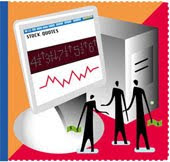 Reader Joe is trying to use some of the finance.yahoo.com features to make it easier to track his sell stops. He had this to say:
Reader Joe is trying to use some of the finance.yahoo.com features to make it easier to track his sell stops. He had this to say:
I have a related question. I too am familiar with finance.yahoo.com. In a blog post a few weeks ago, you stated the user could download information into a spreadsheet and make adjustments from there. I note finance.yahoo.com allows the user to set alerts.
Yahoo also maintains daily price history for several years. Wouldn’t it be easier, and just as effective, to determine the high price during the user’s holding period, determine the stop limit, 6% / 7%, etc. and then set an alert in finance.yahoo.com? Apparently the program sends alerts to the user’s email address.
This can work for you as long as you are aware of a few shortcomings with this approach:
1. When you set the alert price, you need to adjust it whenever the market rallies and your old high price gets taken out. Remember, this is a trailing stop loss point and not a static one.
2. In the case of ETFs, Yahoo’s alert will get triggered whenever your alert price is hit, even on an intraday basis. I use only day-ending prices as a basis for my stops.
3. When distributions occur, your trigger prices need to be adjusted to reflect this distribution as I wrote in Honing In On Bond Funds And Sell Stops.
If you are aware of these shortcomings and can live with them, by all means, use these Yahoo features. While technology is wonderful, it is not perfect, which means you can’t count 100% on receiving you email alerts on time.

Comments 3
I've been using the Yahoo pages for years to analise and track my portfolios, and for the past couple of months have been downloading the day's data into my spreadsheet, where it calculates the closing stop loss for me based on my preset percentages, which are diferent for ETFs, funds and stocks. It works well, and no whip-lash without my considered and intended actions the next day.
It is good from the aspect that it imposes a disciplined routine of paying attention to investments and spotting trends. Yahoo also provides some limited candlestick charting capabilites, which can be used with other technical analysis tools they provide, to evaluate the trends and make decisions on exiting a position.
Tom C.
finviz.com is a good free site to use for "technical analysis" for trending. One feature I like is the screener performance tab. I can sort a portfolio on any column and then when I move to the charts tab, the charts are in the same order. I can quickly spot the best trends in the performance order I want. Works great with watch portfolios for sectors, country, domestic, etc. It's easy to add ETFs to a watch portfolio by simply using today's value and still get past performance info.
If you look at "Historical Prices" under Yahoo, you'll see and "adjusted price" – the right hand most column. THAT price indeed reflects any distributions made by the mutual fund.
So using the alert feature as you said Uli would require continuously updating the price on Yahoo. However looking at the RHS column and then updating a custom spreadsheet – like yours Uli – is a reasonable approach. In fact, that's what I do.
Cheers.